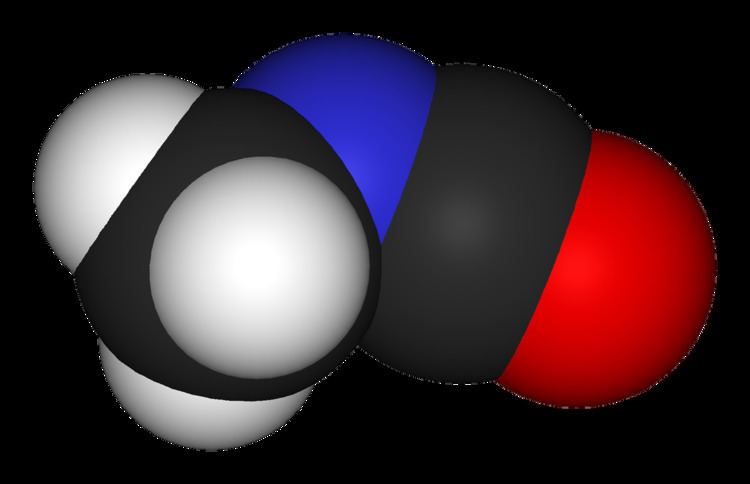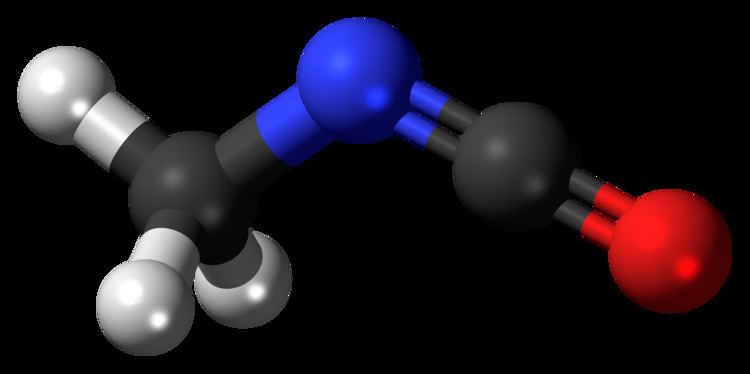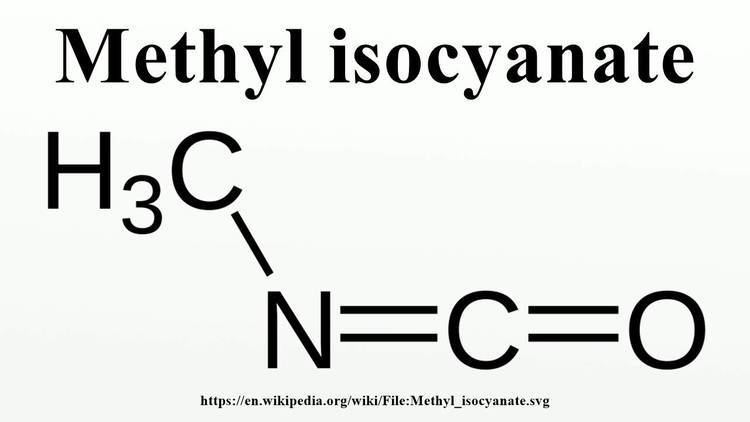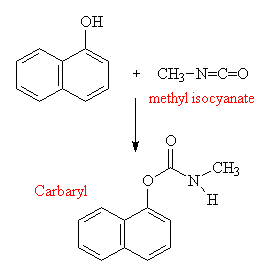Appearance Colorless liquid Formula C2H3NO Density 923 kg/m³ Melting point -45 °C | Related compounds Boiling point 39.5 °C Molar mass 57.051 g/mol | |
 | ||
Methyl isocyanate
Methyl isocyanate (MIC) is an organic compound with the molecular formula CH3NCO. Synonyms are isocyanatomethane, methyl carbylamine, and MIC. Methyl isocyanate is an intermediate chemical in the production of carbamate pesticides (such as carbaryl, carbofuran, methomyl, and aldicarb). It has also been used in the production of rubbers and adhesives. As a highly toxic and irritating material, it is extremely hazardous to human health. It was the principal toxicant involved in the Bhopal disaster, which killed nearly 2,259 people initially and officially 3,787 people in total.
Contents
- Methyl isocyanate
- Physical properties
- Manufacture
- Reactions
- Uses
- Hazards
- Extraterrestrial occurrence
- References

Methyl isocyanate
Physical properties

Methyl isocyanate (MIC) is a colorless, lachrymatory (tearing agent), flammable liquid. It is soluble in water to 6–10 parts per 100 parts, but it also reacts with water (see Reactions below).
Manufacture

Methyl isocyanate is usually manufactured by the reaction of monomethylamine and phosgene. For large scale production, it is advantageous to combine these reactants at higher temperature in the gas phase. A mixture of methyl isocyanate and two moles of hydrogen chloride is formed, but N-methylcarbamoyl chloride (MCC) forms as the mixture is condensed, leaving one mole of hydrogen chloride as a gas.

The methyl isocyanate is obtained by treating the MCC with a tertiary amine, such as N,N-dimethylaniline, or with pyridine or by separating it by using distillation techniques.

Methyl isocyanate is also manufactured from N-methylformamide and air. In the latter process, it is immediately consumed in a closed-loop process to make methomyl. Other manufacturing methods have been reported.
Reactions
Methyl isocyanate reacts readily with many substances that contain N-H or O-H groups. With water, it forms 1,3-dimethylurea and carbon dioxide with the evolution of heat (325 calories per gram of MIC):
At 25 °C, in excess water, half of the MIC is consumed in 9 min.; if the heat is not efficiently removed from the mixture, the rate of the reaction will increase and rapidly cause the MIC to boil. If MIC is in excess, 1,3,5-trimethylbiuret is formed along with carbon dioxide. Alcohols and phenols, which contain an O-H group, react slowly with MIC, but the reaction can be catalyzed by trialkylamines or dialkyltin dicarboxylate. Oximes, hydroxylamines, and enols also react with MIC to form methylcarbamates. These reactions produce the products described below (Uses).
Ammonia, primary, and secondary amines rapidly react with MIC to form substituted ureas. Other N-H compounds, such as amides and ureas, react much more slowly with MIC.
It also reacts with itself to form a trimer or higher molecular weight polymers. In the presence of catalysts, MIC reacts with itself to form a solid trimer, trimethyl isocyanurate, or a higher molecular weight polymer:
Sodium methoxide, triethyl phosphine, ferric chloride and certain other metal compounds catalyze the formation of the MIC-trimer, while the high-molecular-weight polymer formation is catalyzed by certain trialkylamines. Since the formation of the MIC trimer is exothermic (298 calories per gram of MIC), the reaction can lead to violent boiling of the MIC. The high-molecular-weight polymer hydrolyzes in hot water to form the trimethyl isocyanurate. Since catalytic metal salts can be formed from impurities in commercial grade MIC and steel, this product must not be stored in steel drums or tanks.
Uses
Methyl isocyanate is an intermediate chemical in the production of carbamate pesticides (such as carbaryl, carbofuran, methomyl, and aldicarb and Bendiocarb). It has also been used in the production of rubbers and adhesives.
MIC is used in the synthesis of Fluzinamide, Caracemide, cloretazine, temozolomide & 1,1-diphenyl-2-propynyl n-methylcarbamate (analog of Enpromate).
Hazards
Methyl isocyanate (MIC) is extremely toxic. The threshold limit value set by the American Conference on Government Industrial Hygienists is 0.02 ppm. MIC is toxic by inhalation, ingestion and contact in quantities as low as 0.4 ppm. Exposure symptoms includes coughing, chest pain, dyspnea, asthma, irritation of the eyes, nose and throat, as well as skin damage. Higher levels of exposure, over 21 ppm, can result in pulmonary or lung edema, emphysema and hemorrhages, bronchial pneumonia and death. Although the odor of methyl isocyanate cannot be detected at 5 ppm by most people, its potent lachrymal properties provide an excellent warning of its presence (at a concentration of 2–4 parts per million (ppm) subject's eyes are irritated, while at 21 ppm, subjects could not tolerate the presence of methyl isocyanate in air).
Proper care must be taken to store methyl isocyanate because of its ease of exothermically polymerizing (see Reactions) and its similar sensitivity to water. Only stainless steel or glass containers may be safely used; the MIC must be stored at temperatures below 40 °C (104 °F) and preferably at 4 °C (39 °F).
The toxic effect of the compound was apparent in the Bhopal disaster, when around 42,000 kilograms (93,000 lb) of methyl isocyanate and other gases were released from the underground reservoirs of the Union Carbide India Limited (UCIL) factory, over a populated area on December 3, 1984, immediately killing thousands.
Extraterrestrial occurrence
On 30 July 2015, scientists reported that upon the first touchdown of the Philae lander on comet 67/P's surface, measurements by the COSAC and Ptolemy instruments revealed sixteen organic compounds, four of which were seen for the first time on a comet, including acetamide, acetone, methyl isocyanate and propionaldehyde.
